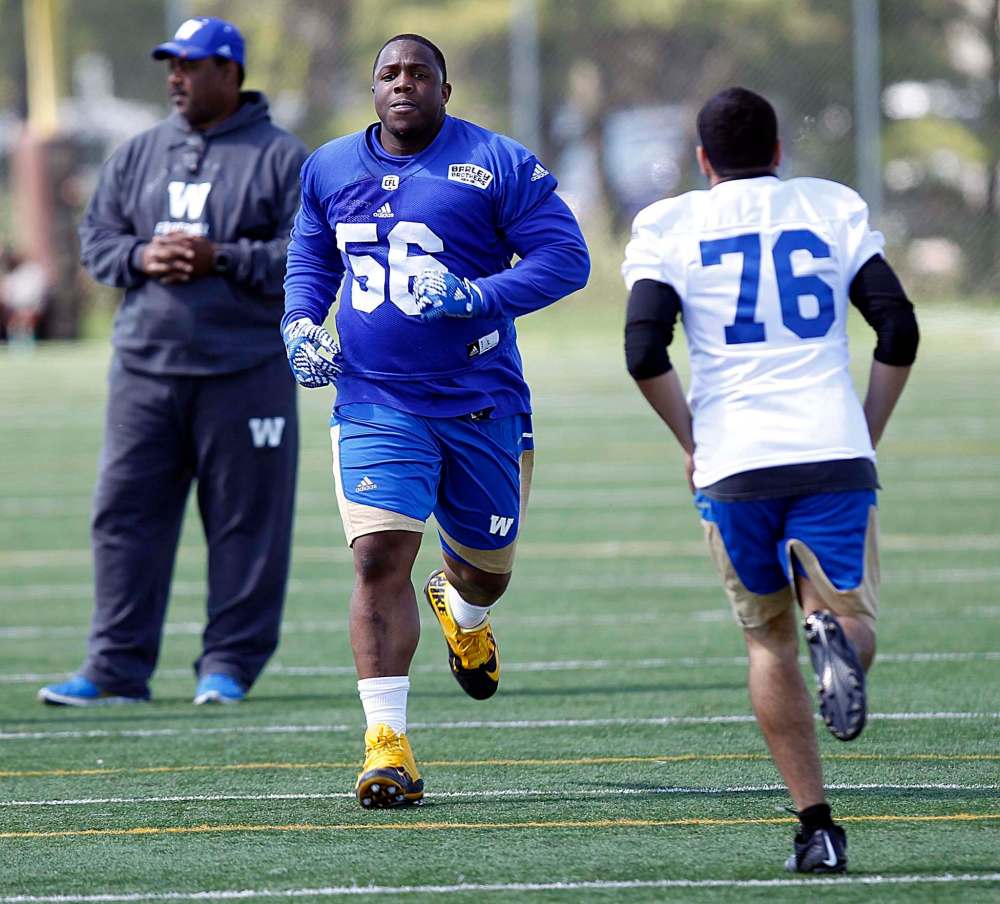U.S.-trained defensive linemen face steep learning curve in CFL
Advertisement
Read this article for free:
or
Already have an account? Log in here »
To continue reading, please subscribe:
Monthly Digital Subscription
$0 for the first 4 weeks*
- Enjoy unlimited reading on winnipegfreepress.com
- Read the E-Edition, our digital replica newspaper
- Access News Break, our award-winning app
- Play interactive puzzles
*No charge for 4 weeks then price increases to the regular rate of $19.00 plus GST every four weeks. Offer available to new and qualified returning subscribers only. Cancel any time.
Monthly Digital Subscription
$4.75/week*
- Enjoy unlimited reading on winnipegfreepress.com
- Read the E-Edition, our digital replica newspaper
- Access News Break, our award-winning app
- Play interactive puzzles
*Billed as $19 plus GST every four weeks. Cancel any time.
To continue reading, please subscribe:
Add Free Press access to your Brandon Sun subscription for only an additional
$1 for the first 4 weeks*
*Your next subscription payment will increase by $1.00 and you will be charged $16.99 plus GST for four weeks. After four weeks, your payment will increase to $23.99 plus GST every four weeks.
Read unlimited articles for free today:
or
Already have an account? Log in here »
Hey there, time traveller!
This article was published 28/05/2018 (2757 days ago), so information in it may no longer be current.
In one of the shortest training camps in professional sport, the danger of the CFL’s brief evaluation period is it sometimes forces a rush to judgment on players. And when it comes to potential on the defensive line, this position can take three or more years to uncap true ability — a luxury many teams don’t have.
The initial difficulty with top defensive line draft picks in the CFL is that if they played college ball in the NCAA, especially in division one programs, they are almost automatically regarded higher than their CIS counterparts. There is more competition, better coaching, and much more financial investment in collegiate football in the U.S. Defensive linemen coming out of division one or two programs tend to be more polished with their fundamentals, have big-game experience, and can be more developed physically, due to the rigours of the multimillion-dollar conditioning programs. So when you compare an apple that played in the CIS for four years, to another apple that played for Nebraska his entire collegiate career, scouts tend to go with the fruit from the more impressive tree.
The problem, however, as I’ve seen countless times, is when you pluck a defensive lineman who has been playing square American football for four years or more, and you jam him into the circle of Canadian football, it doesn’t always fit right away. And often teams get frustrated and give up on a player. They don’t understand how much time and investment is required to fully integrate a U.S.-trained player into the Canadian game. In fact, if teams are looking for immediate benefit from a first-round defensive line talent—and don’t have the timeline or patience to develop a NCAA one — they would, in many instances, be better off selecting the prospect that played Canadian university ball.

The biggest hurdle for an American-football-trained prospect is the CFL’s pass-first reality. In American ball, stopping the run is the foundation and basis of your technique. You drill your run keys incessantly, because if you can’t stop the run south of the border, they won’t stop driving the ball down main street at you. On first and second down, it’s run heavy, and depending on the down and distance, third down can have a run emphasis too.
In the CFL these days, it’s almost exactly opposite. It’s pass heavy first and second down, and the run game is a sprinkling that is thrown at you as a change-up, and to ensure defensive linemen are kept honest, and not cheating upfield.
So what difficulties does this present for U.S.-trained interior defensive linemen? Quite simply, they have missed out on the thousands of first- and second-down passing repetitions, cues and reads that CIS-trained linemen are accustomed to. They are looking for run-stopping keys on first and second down that simply aren’t there north of the border.
The hardest thing in transitioning from college football to professional football is the amount of recognition the pro game requires. On any given snap, you have to be able to process down and distance, pre-snap cues and keys gained from film study, whether your opponent is sitting heavy (run) or light (pass), and then, whether it is a play action look that reads like a run but is actually a pass. Or whether it looks like a pass, but is instead a draw or a screen play. By the time your first step is in the ground, you have to have recognized, processed and have adjusted for anything from 600-plus pounds of force from a double team, to a slide protection pass rush that you need to backdoor.
In college football in the U.S., you stop the run first, and then you get after the pass. Many players are specialized as run stoppers, and actually come out of the game if the distance remaining is more than five yards. In the CFL, you have to reverse that thinking. Your foundation and basis of your get off and attack is your pass-rushing arsenal, and you have to sniff out the runs along the way.
If you look at the recent interview with last year’s first round project, Faith Ekakitie, by Free Press reporter Mike Sawatzky, these are exactly the issues he is currently contending with. “The technical side of pass-rushing, I understand it, but actually getting it done and having the ability to rep it out over and over again, and have that feel for being a good, explosive pass-rusher. I think that’s where I’m really lacking—that repetition.”
When a team drafts American-trained defensive linemen who were primarily used as run-stopping cogs, the transition to the pass-happy CFL is a long, and sometimes, arduous road — for the player and management. This difficulty is only magnified in a short training camp, where teams often have to make impulsive decisions on players that are faced with near unrealistic expectations of their evolutions.
Doug Brown, once a hard-hitting defensive lineman and frequently a hard-hitting columnist, appears weekly in the Free Press.
Twitter: @DougBrown97






